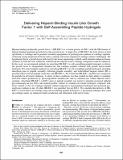| dc.contributor.author | Miller, Rachel Elizabeth | |
| dc.contributor.author | Mroszczyk, Keri A. | |
| dc.contributor.author | Lee, Richard T. | |
| dc.contributor.author | Patwari, Parth | |
| dc.contributor.author | Grodzinsky, Alan J. | |
| dc.contributor.author | Florine, Emily Marie | |
| dc.contributor.author | Liebesny, Paul Hancock | |
| dc.date.accessioned | 2015-03-04T16:05:05Z | |
| dc.date.available | 2015-03-04T16:05:05Z | |
| dc.date.issued | 2014-10 | |
| dc.date.submitted | 2013-11 | |
| dc.identifier.issn | 1937-3341 | |
| dc.identifier.issn | 1937-335X | |
| dc.identifier.uri | http://hdl.handle.net/1721.1/95793 | |
| dc.description.abstract | Heparin-binding insulin-like growth factor 1 (HB-IGF-1) is a fusion protein of IGF-1 with the HB domain of heparin-binding epidermal growth factor-like growth factor. A single dose of HB-IGF-1 has been shown to bind specifically to cartilage and to promote sustained upregulation of proteoglycan synthesis in cartilage explants. Achieving strong integration between native cartilage and tissue-engineered cartilage remains challenging. We hypothesize that if a growth factor delivered by the tissue engineering scaffold could stimulate enhanced matrix synthesis by both the cells within the scaffold and the adjacent native cartilage, integration could be enhanced. In this work, we investigated methods for adsorbing HB-IGF-1 to self-assembling peptide hydrogels to deliver the growth factor to encapsulated chondrocytes and cartilage explants cultured with growth factor-loaded hydrogels. We tested multiple methods for adsorbing HB-IGF-1 in self-assembling peptide hydrogels, including adsorption prior to peptide assembly, following peptide assembly, and with/without heparan sulfate (HS, a potential linker between peptide molecules and HB-IGF-1). We found that HB-IGF-1 and HS were retained in the peptide for all tested conditions. A subset of these conditions was then studied for their ability to stimulate increased matrix production by gel-encapsulated chondrocytes and by chondrocytes within adjacent native cartilage. Adsorbing HB-IGF-1 or IGF-1 prior to peptide assembly was found to stimulate increased sulfated glycosaminoglycan per DNA and hydroxyproline content of chondrocyte-seeded hydrogels compared with basal controls at day 10. Cartilage explants cultured adjacent to functionalized hydrogels had increased proteoglycan synthesis at day 10 when HB-IGF-1 was adsorbed, but not IGF-1. We conclude that delivery of HB-IGF-1 to focal defects in cartilage using self-assembling peptide hydrogels is a promising technique that could aid cartilage repair via enhanced matrix production and integration with native tissue. | en_US |
| dc.description.sponsorship | National Science Foundation (U.S.). Graduate Research Fellowship Program | en_US |
| dc.description.sponsorship | National Institutes of Health (U.S.) (Grant EB003805) | en_US |
| dc.description.sponsorship | National Institutes of Health (U.S.) (Grant AR060331) | en_US |
| dc.description.sponsorship | Whitaker Health Sciences Fund Fellowship | en_US |
| dc.description.sponsorship | Massachusetts Life Sciences Center | en_US |
| dc.description.sponsorship | Biomeasure, Inc. | en_US |
| dc.language.iso | en_US | |
| dc.publisher | Mary Ann Liebert, Inc. | en_US |
| dc.relation.isversionof | http://dx.doi.org/10.1089/ten.TEA.2013.0679 | en_US |
| dc.rights | Article is made available in accordance with the publisher's policy and may be subject to US copyright law. Please refer to the publisher's site for terms of use. | en_US |
| dc.source | Mary Ann Liebert | en_US |
| dc.title | Delivering Heparin-Binding Insulin-Like Growth Factor 1 with Self-Assembling Peptide Hydrogels | en_US |
| dc.type | Article | en_US |
| dc.identifier.citation | Florine, Emily M., Rachel E. Miller, Paul H. Liebesny, Keri A. Mroszczyk, Richard T. Lee, Parth Patwari, and Alan J. Grodzinsky. “Delivering Heparin-Binding Insulin-Like Growth Factor 1 with Self-Assembling Peptide Hydrogels.” Tissue Engineering Part A 21, no. 3–4 (February 2015): 637–646. © 2014 Mary Ann Liebert, Inc. | en_US |
| dc.contributor.department | Lincoln Laboratory | en_US |
| dc.contributor.department | Massachusetts Institute of Technology. Department of Biological Engineering | en_US |
| dc.contributor.mitauthor | Florine, Emily Marie | en_US |
| dc.contributor.mitauthor | Liebesny, Paul Hancock | en_US |
| dc.contributor.mitauthor | Mroszczyk, Keri A. | en_US |
| dc.contributor.mitauthor | Grodzinsky, Alan J. | en_US |
| dc.relation.journal | Tissue Engineering. Part A | en_US |
| dc.eprint.version | Final published version | en_US |
| dc.type.uri | http://purl.org/eprint/type/JournalArticle | en_US |
| eprint.status | http://purl.org/eprint/status/PeerReviewed | en_US |
| dspace.orderedauthors | Florine, Emily M.; Miller, Rachel E.; Liebesny, Paul H.; Mroszczyk, Keri A.; Lee, Richard T.; Patwari, Parth; Grodzinsky, Alan J. | en_US |
| dc.identifier.orcid | https://orcid.org/0000-0002-4942-3456 | |
| dc.identifier.orcid | https://orcid.org/0000-0002-4121-8183 | |
| dc.identifier.orcid | https://orcid.org/0000-0002-5770-838X | |
| mit.license | PUBLISHER_POLICY | en_US |
| mit.metadata.status | Complete | |
